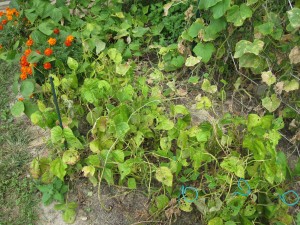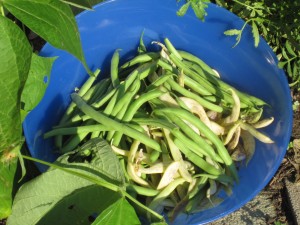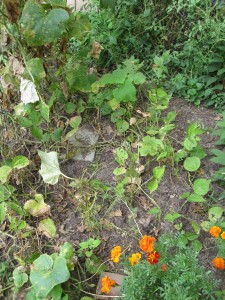I started cleaning up the garden for winter, pulling spent Dragon’s Tongue bush beans, weeds, and clearing dead leaves and other debris. End-of-season plants are not so pretty plus they can harbor disease and pests. Besides, I like the look of a freshly cleaned garden. I also wanted to plant spinach and turnip seeds in that space. Still it’s a difficult task, not the physical labor of it, but emotionally. I pull each small bush up, one at a time, and shake whatever soil still clings to the roots. I feel a strong connection with these withering branches, a real familiarity. I planted the seeds, watered the plants, and harvested the surprisingly large amount of beans throughout the summer.
My association with Dragon’s Tongue wax bush beans goes back nine months to last Christmas when our middle son and his wife gave me several colorful packets of heirloom seeds from a company that collects and sells unique varieties. My first reaction at seeing wax bean seeds, except for liking the artwork on the packet, was a little negative. I have a childhood memory of yellow beans in a grandmother-made three-bean salad, mealy, vinegary and over-onioned. That memory plus the name (wax? like gnawing on a candle?) steered me clear of this type of bean my entire adult life until now.
I planted these in mid-May in the Lorelei next to my wall of cucumbers. I felt chagrined at my childish aversion to wax beans as soon as I picked and crunched the first one a month and a half later. (I love snacking on raw beans in the garden, so sweet, so crisp, a real treat!). These purple-streaked chiffon-yellow beauties were tender, string-less, and delicious. Steamed for a few minutes or cooked longer with a little bacon, Dragon’s Tongue makes a delectable dish. The beans amazed me that they could grow so large, a half inch wide and six to seven inches long, looking to my eye overgrown, yet still be tender and good. I wonder, writing this now, if that’s how they were supposed to be, long and flat like a tongue, and why this variety has its unique name. Another thing about these beans: the foot high bushes produced two separate harvests with smaller pickings before and after, almost making three harvests from one planting. Even as I pulled the finished plants, I could see a few brave purple blossoms ready for more. So prolific, these beans, they were a true joy to grow.
The time had come, nevertheless, to pull the now bare plants, mostly stems and branches, an echo of their former glory. While clearing them out, I discovered several pods, maybe seven or eight I missed in the last pickings. I left the bushes bearing those, hoping they would mature into Dragon’s Tongue seed to plant next year. After a heavy spate of rain a bit ago, it’s been pretty dry around here for the last couple of weeks, so I’m not sure if the bean seeds will reach maturity. We’ll see.
I said thank you to these now-empty bushes, such hearty producers of lovely and tasty beans. What an odd mixture of satisfaction and melancholy, clearing a garden at the end of the growing season. I suppose that’s how it always is when you get involved with other living things.



